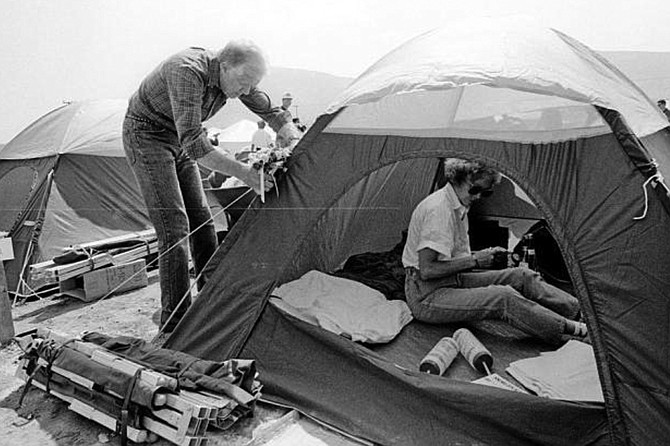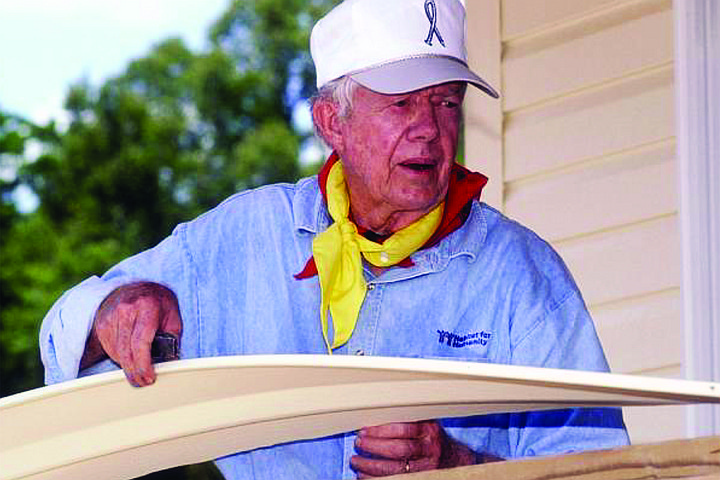 Facebook
Facebook
 X
X
 Instagram
Instagram
 TikTok
TikTok
 Youtube
Youtube

I was reminded of my meeting with President Jimmy Carter the other day when news broke that the organization he’s intimately involved with, Habitat For Humanity, had come up with their first-ever 3-D printed house. It’s a three-bedroom, two-bath home basically made of concrete, which they built in Williamsburg, Virginia. It took them just 12 hours to build, as opposed to the four weeks that Habitat would normally require. I mean, this has to be a game-changer, and not just for Habitat.
Like everybody, I reckon Mr. Carter has to be the best ex-president ever. But that reckoning has had a personal aspect ever since I turned up in 1990 southeast of Tijuana, where the Carters were helping 3000 volunteers build hundreds of houses. It was dusk. I had just missed a beautiful candlelight procession of thanks through the hills of Tijuana. In fact, I thought I had missed everything, but then I heard this tap tap tap coming from inside one of the unfinished houses. I climbed up through the rubble to where this one light was shining dankly in the dusk, and saw a lone man with a hammer working on some framing. I couldn’t tell who it was until I knocked and walked through the door.

It was Jimmy Carter, with hammer, nails, and a piece of timber. Alone. No guards, no Secret Service as far as I could tell. Just him and his hammer in the house. I introduced myself and we talked as he worked on, racing the fading daylight. The guy has been building houses for poor people since he and Roselynn founded the Jimmy and Roselynn Carter Work Project in 1986, two years after they started with Habitat for Humanity. They say he has worked with over 100,000 volunteers, and built or renovated nearly 5000 homes for people from his home state of Georgia to the Philippines to Africa to you name it. Every year, without respite.
So I stood there, and he just kept on tapping away while I tried to ask him questions that he hadn’t been asked 100,000 times before. He was nice enough to let me carry on. But I didn’t want to hold him up. So I said my goodbyes, and retreated as his tap-tap-taps got swallowed up in the earthy sounds of a working twilight and melded with chat and laughs and dog yelps and far-off yips of coyotes and kids’ giggles and ranchero music on someone’s radio. And somewhere, the smell of carne asada wafted forth. I tried to print it all — in 3-D, natch — on my brain, so I would remember the moment.
I don’t know what else Jimmy Carter has done with his life. OK, yes I do. But this was enough for me. I walked slowly up the shadowy hill, marveling at the ecosystem that one man can create — drawing along a comet-stream of good people behind a beautiful idea.
I doubt the whole 3-D innovation will change that one iota.


I was reminded of my meeting with President Jimmy Carter the other day when news broke that the organization he’s intimately involved with, Habitat For Humanity, had come up with their first-ever 3-D printed house. It’s a three-bedroom, two-bath home basically made of concrete, which they built in Williamsburg, Virginia. It took them just 12 hours to build, as opposed to the four weeks that Habitat would normally require. I mean, this has to be a game-changer, and not just for Habitat.
Like everybody, I reckon Mr. Carter has to be the best ex-president ever. But that reckoning has had a personal aspect ever since I turned up in 1990 southeast of Tijuana, where the Carters were helping 3000 volunteers build hundreds of houses. It was dusk. I had just missed a beautiful candlelight procession of thanks through the hills of Tijuana. In fact, I thought I had missed everything, but then I heard this tap tap tap coming from inside one of the unfinished houses. I climbed up through the rubble to where this one light was shining dankly in the dusk, and saw a lone man with a hammer working on some framing. I couldn’t tell who it was until I knocked and walked through the door.

It was Jimmy Carter, with hammer, nails, and a piece of timber. Alone. No guards, no Secret Service as far as I could tell. Just him and his hammer in the house. I introduced myself and we talked as he worked on, racing the fading daylight. The guy has been building houses for poor people since he and Roselynn founded the Jimmy and Roselynn Carter Work Project in 1986, two years after they started with Habitat for Humanity. They say he has worked with over 100,000 volunteers, and built or renovated nearly 5000 homes for people from his home state of Georgia to the Philippines to Africa to you name it. Every year, without respite.
So I stood there, and he just kept on tapping away while I tried to ask him questions that he hadn’t been asked 100,000 times before. He was nice enough to let me carry on. But I didn’t want to hold him up. So I said my goodbyes, and retreated as his tap-tap-taps got swallowed up in the earthy sounds of a working twilight and melded with chat and laughs and dog yelps and far-off yips of coyotes and kids’ giggles and ranchero music on someone’s radio. And somewhere, the smell of carne asada wafted forth. I tried to print it all — in 3-D, natch — on my brain, so I would remember the moment.
I don’t know what else Jimmy Carter has done with his life. OK, yes I do. But this was enough for me. I walked slowly up the shadowy hill, marveling at the ecosystem that one man can create — drawing along a comet-stream of good people behind a beautiful idea.
I doubt the whole 3-D innovation will change that one iota.
Comments